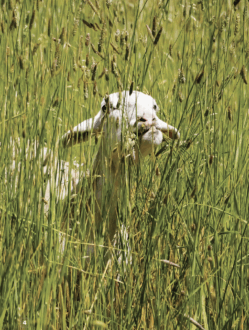Wildfires throughout the West are growing more severe. Fire season starts earlier, lasts longer and claims more lives and property along the way. Grazing is one of the most effective, cost-efficient tools available to lessen fire spread and severity. And now, thanks to a recent Western SARE-supported project, grazing has become even more useful to resource managers, landowners and livestock producers alike.
“Grazing offers a unique opportunity to reduce fire fuels, mitigate climate change and support local agriculture,” said Stephanie Larson, Cooperative Extension livestock and range advisor for the University of California based in Sonoma County. “Our project helps match landowners with grazing contractors and also highlights the nutritional value of many rangeland plants commonly grazed to reduce fuel loads.”
By reducing the mass and height of shrubs and grasses, grazing can make all the difference in fighting fires. When livestock munch three-foot grasses down to six inches, for example, fires stay on the surface where firefighters can effectively extinguish flames.
Larson and her team are building a community of land managers, educators and grazers who can work together to reduce fire fuel loads in some of the most wildfire-prone landscapes in California, especially in wildland-urban interfaces. The project builds on Match.Graze, an online tool Larson’s team created to help landowners and grazers find their perfect match.
“It’s like Tinder for livestock,” Larson explained. “Every property is different and requires thoughtful consideration on how it should best be grazed.”
The platform lets property owners create profiles about the land they have available for grazing while herders share information about their cattle, goats or sheep for hire. Match.Graze has over 200 users in California’s Bay Area alone and continues to grow throughout northern California.
Larson’s SARE project is also helping landowners and livestock managers understand the nutritional value that can come from grazing to reduce fire fuel loads. Most current research on rangeland nutrition focuses on what livestock need for meat and milk production.
“We’re analyzing the nutrient, fiber and protein content of the brush and grasses most commonly grazed to reduce fire fuel, not for animal production,” Larson said. “Producers want to be able to educate their herders about forage quality and quantity to protect animal welfare. It helps clarify how many animals might be needed to graze various landscapes at different times, for example, and whether livestock will need supplemental feed.
The team has created a Brush Management/Nutritional Field Guidebook, available by contacting Larson at slarson@ucanr.edu or contacting the UC Cooperative Extension Sonoma County office at (707) 565-2621.
“We are committed to supporting grazers in managing public and private lands by providing research-based technical support,” Larson said. “Let’s work together to prevent catastrophic fire while helping landowners and livestock grazers succeed.”
This story was featured in the spring 2025 edition of Western SARE's bi-annual magazine Simply Sustainable. Download the entire edition here.
View Related SARE Grant:
- Targeted Grazing for Fuel Load Reduction (OW22-373)
